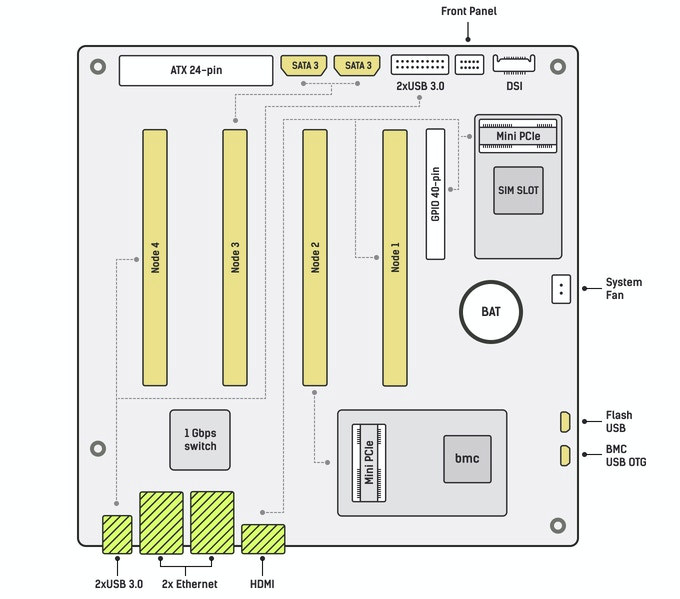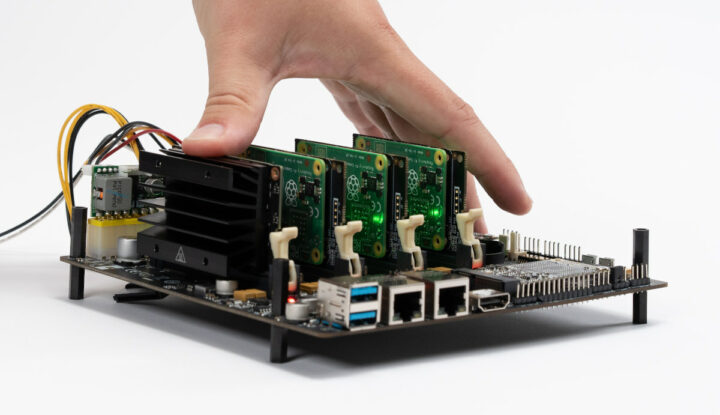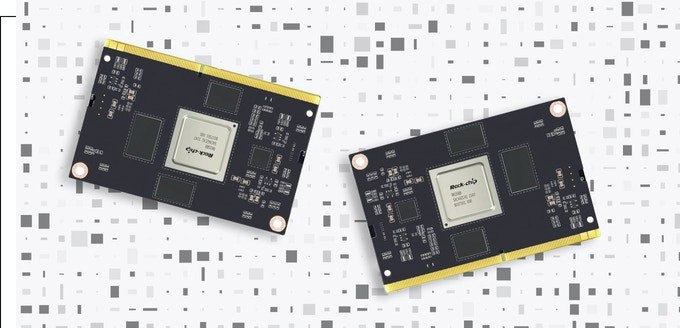We first covered the Turing Pi V2 mini-ITX cluster board supporting up to four Raspberry Pi CM4 or NVIDIA Jetson SO-DIMM system-on-module in August 2021. The company has now launched the Turing Pi 2 on Kickstarter with a little surprise: the Turing RK1 module with Rockchip RK3588 Cortex-A76/A55 processor and up to 32GB RAM.
The board allows you to mix and match modules (e.g. 3x RPi CM4 + 1x Jetson module as on the photo below), and with SATA ports, Gigabit Ethernet networking, USB 3.0 ports, mPCIe socket, you could build a fairly powerful homelab, learn Kubernetes, or self-host your own apps.
Turing Pi 2 specifications:
- SoM interface – 4x 260-pin SO-DIMM slots for up to four
- Raspberry Pi CM4 with Broadcom quad-core Cortex-A72 processor, up to 8GB RAM, up to 32GB eMMC flash (adapter needed)
- NVIDIA Jetson Nano/TX2 NX/Xavier NX SO-DIMM system-on-modules with up to 6x Armv8 cores, and 16GB RAM.
- Turing RK1 with Rockchip RK3588 octa-core Cortex-A76/A55 processor, up to 32GB RAM, eMMC flash
- Storage – 2x SATA III ports via a PCIe controller connected to one module
- Video Output – 1x HDMI port, 1x MIPI DSI header
- Audio – Digital audio via HDMI
- Network connectivity
- 2x Gigabit Ethernet RJ45 ports
- 1 Gbps 7-port L2 managed switch with IEEE802.1Q VLAN for the two RJ45 ports, four Gigabit Ethernet interfaces between the modules, and 100Mbps for the BMC
- USB – 2x USB 3.0 Type-A ports, 2x USB 3.0 via header
- Expansion
- 2x mPCIe sockets, each connected to a specific module, including one with a SIM card socket
- I2C header for cluster management
- 40-pin GPIO header
- Misc – RTC + coincell battery holder, system fan connector, front panel header, Board Management Controller (BMC) with remote access
- Power Supply – 24-pin ATX header
- Power Consumption – Less than 60W with four NVIDIA modules
- Dimensions – 170 x 170 mm (Mini-ITX form factor)

Some more details about the upcoming Turing RK1 module:
- SoC – Rockchip RK3588 octa-core processor with 4x Arm Cortex-A76 @ 2.4 GHz, 4x Arm Cortex-A55 @ 1.8 GHz, Arm Mali-G610 MP4 GPU, 6 TOPS NPU, 8K 10-bit video decoder, 8K video encoder
- System Memory – Up to 32GB LPDDR4x/LPDDR5
- Storage – TBD eMMC 5.1 flash
- PCIe Gen 3.0
If we don’t have the full specifications yet, that’s because the module is not quite ready.
The company will provide an open-source firmware for the BMC to ease remote board management through a command-line interface. Turing Pi 2 can be used as a learning platform for tools such as Kubernetes, Prometheus, Docker, and Serverless, a self-hosted home lab with various web services such as Home Assistant, media streaming services, gaming servers, office packages, messengers, etc…, as well as for data science when connecting one or more Jetson module with AI accelerators.
Turing Pi 2 mini-ITX cluster board has just launched on Kickstarter and has raised over one million dollars in less than a day. The early bird rewards ($199) are all gone, but you can still pledge $219 to get the board. That’s without any system-on-modules and accessories. The company explains that you will receive a link to a survey where you can select the compute modules and accessories you need in order to secure all the supplies with vendors. The shipping fee is also to-be-determined but estimated from $15 (USA) up to $70 depending on the destination country.

Jean-Luc started CNX Software in 2010 as a part-time endeavor, before quitting his job as a software engineering manager, and starting to write daily news, and reviews full time later in 2011.
Support CNX Software! Donate via cryptocurrencies, become a Patron on Patreon, or purchase goods on Amazon or Aliexpress






